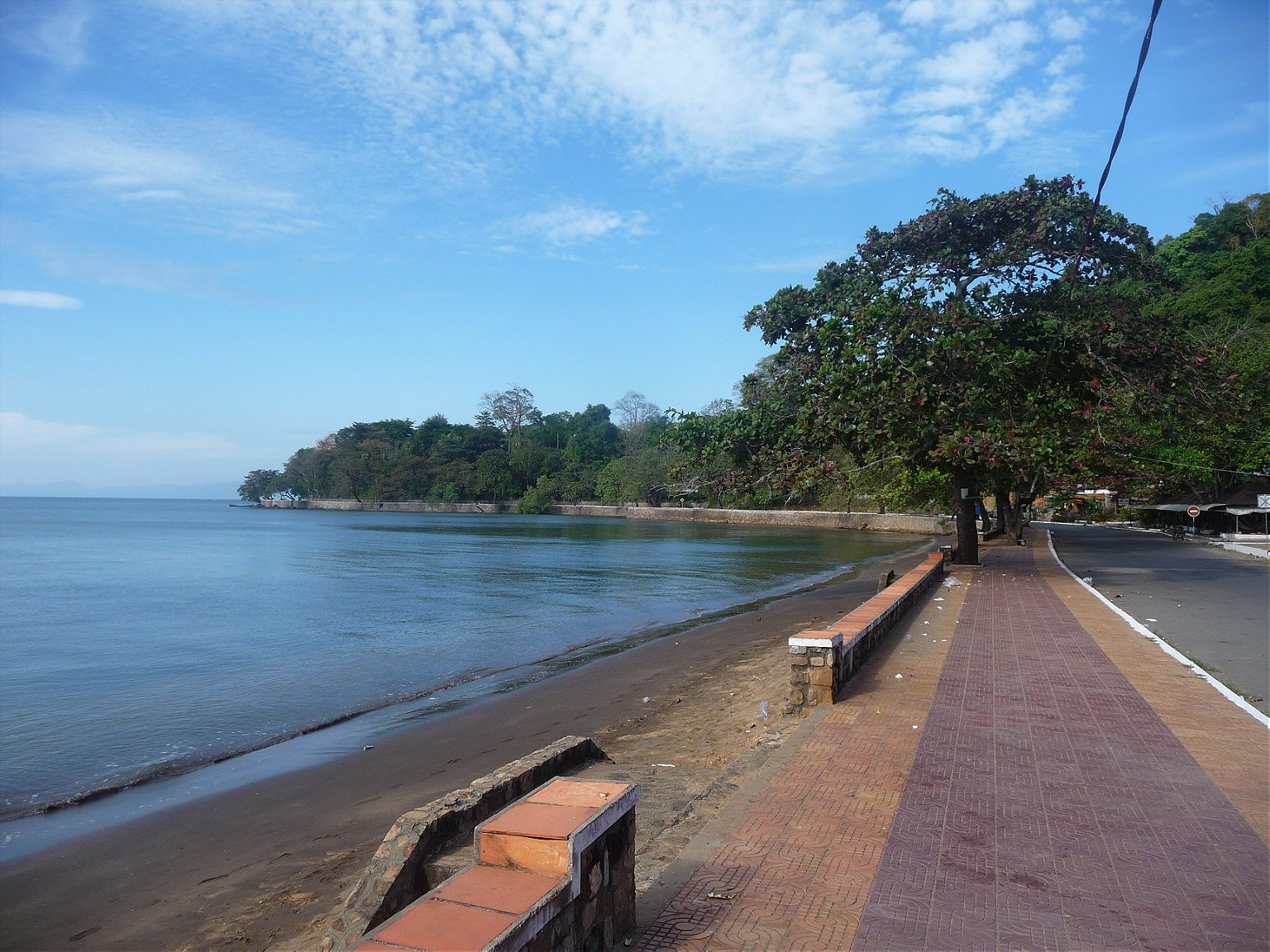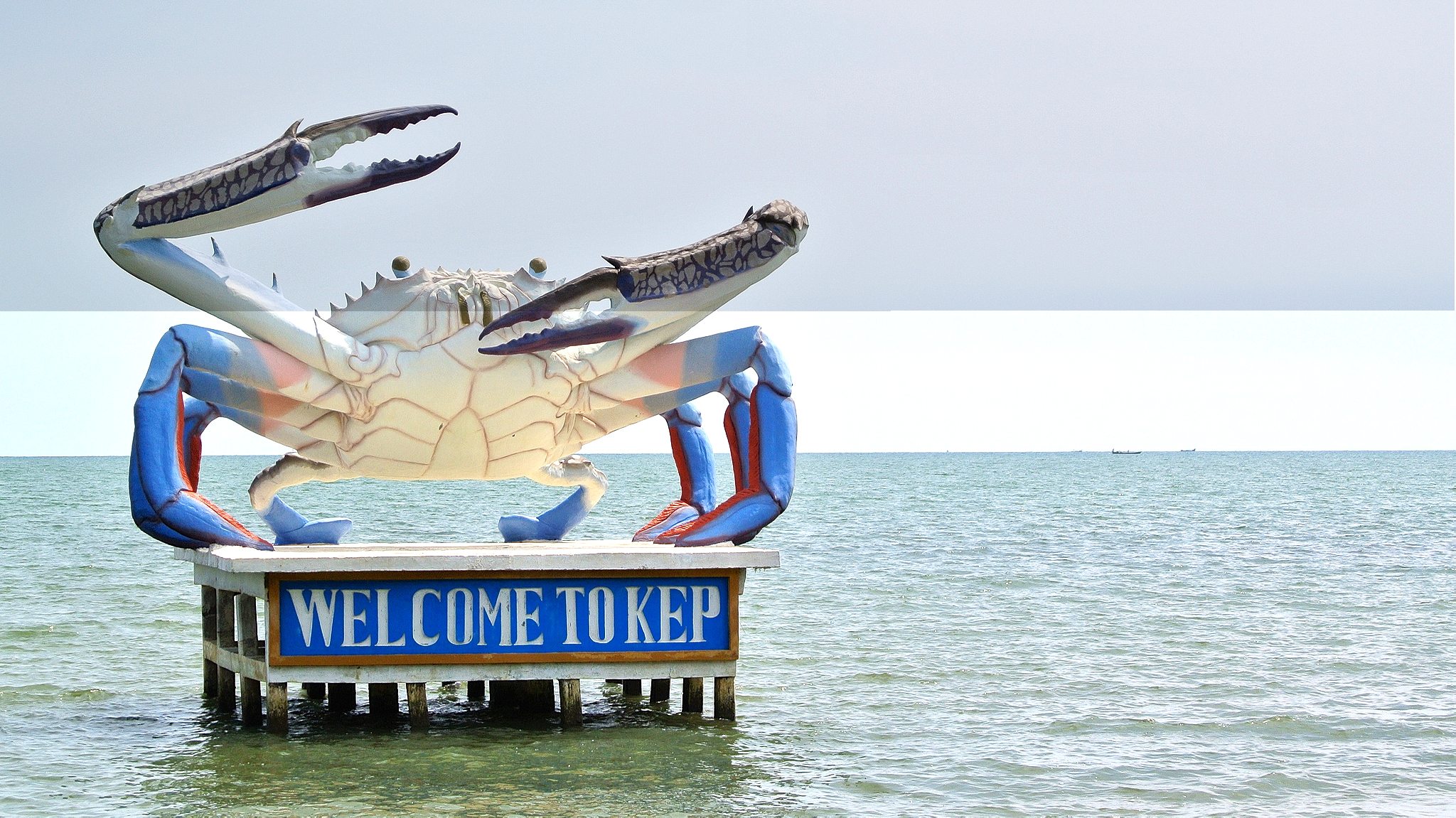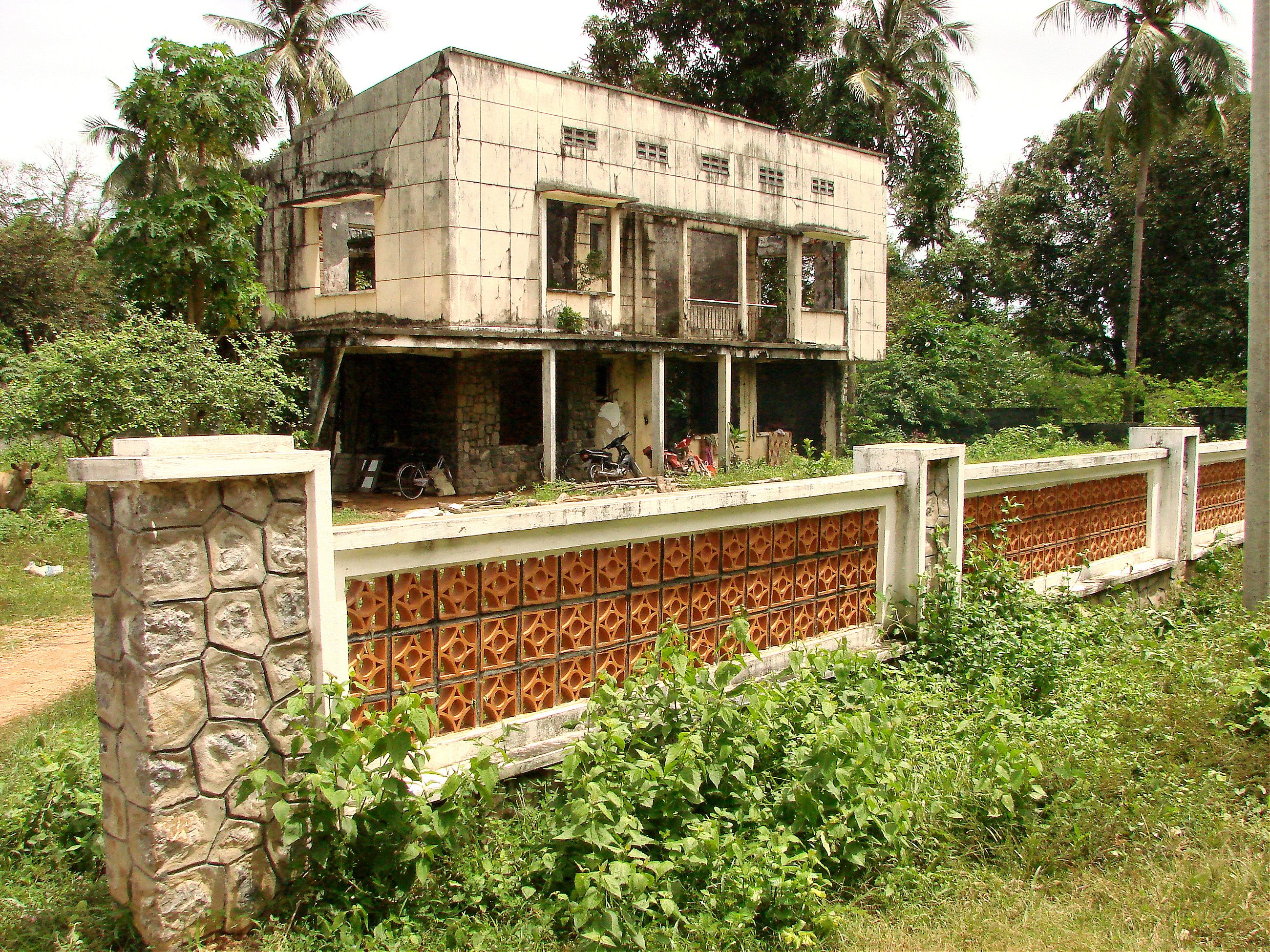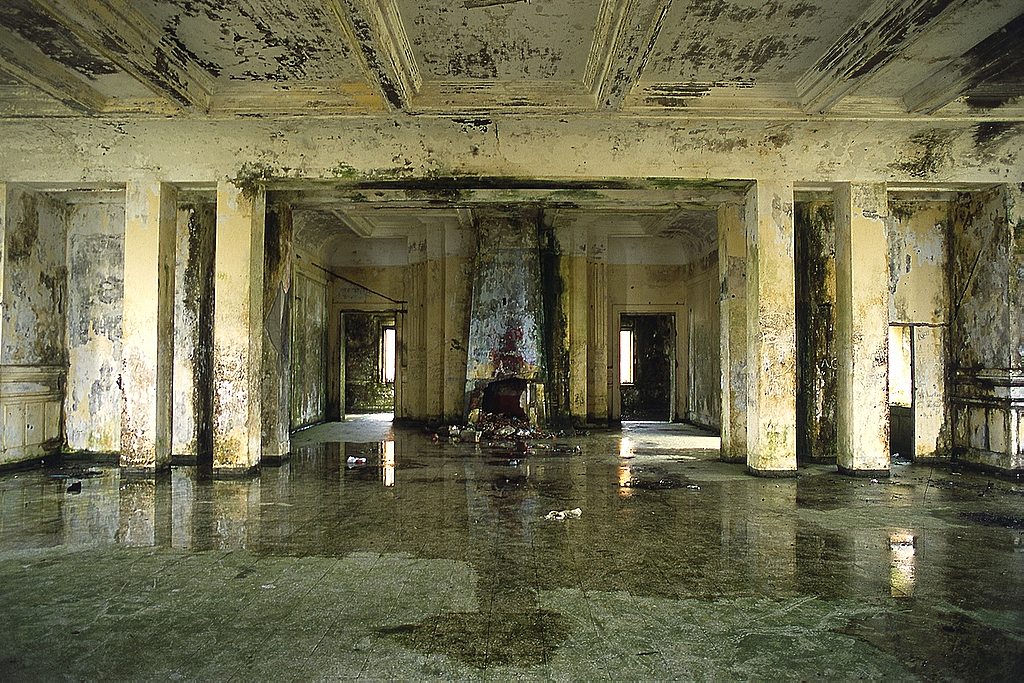The once-glorious beach towns of Kep and Kampot struggle to shake their troubled pasts.
KEP, Cambodia—
There are dogs guarding the king’s house on this quiet hill in Kep, on Cambodia’s south coast, but it doesn’t take much to scare them off. All the same, I feel more comfortable with the sturdy stick found on the dirt path leading up to the property. And the stick proves useful for clearing the jungle undergrowth that surrounds the path—the king left here long ago.
The hounds belong to a Khmer family that’s moved in to keep an eye on the place; laundry hangs on lines between trees, soup bubbles on a stove, and a matriarch in her mid-50s grants permission to explore further with smiles and a friendly wave. I don’t intrude inside—the contents, and anything else not held in place by cement, were stripped out long ago and all that’s left, apart from the structure, are bullet holes and broken tiles.
This former royal residence was once proudly part of a region glorified during the 1960s as the “Cambodian Riviera,” before war and a crazed dictator who wiped out one-fifth of the country’s population sent the country spiraling back toward the Dark Ages. Today, even as places like Kep and its neighboring town of Kampot have rebuilt much of their lost prestige, old wounds are allowed to linger in the form of dozens of buildings from this golden age left abandoned. Locals tell me they’ve been allowed to fall derelict for a number of reasons, but one in particular stands out: Why take care of the past, people wonder, when the past couldn’t take care of you?
At the king’s house, I head to the furthermost cliff point, behind an arched portico that forms the villa’s grandiose rear, to behold the famous view, over the Gulf of Thailand, of the Vietnamese island of Phu Quoc. Here the villa’s long-dead owner, King Norodom Sihanouk, is reputed to have gazed out in sorrow and anger over the island’s lost sovereignty.
Kep’s wealthy left their tennis courts, swimming pools, and landscaped gardens to rebels and rot
He wouldn’t have known far worse was to come. In 1954, when Sihanouk was plotting the island’s return—Phu Quoc, known in Khmer as Koh Tral, has been under Vietnamese administration since a colonial carve-up in 1939—life was looking sweet for the young prince and his country while the tiny town of Kep was blossoming as an international destination resort.
By 1970, when Sihanouk was forced to flee to Beijing by the outbreak of civil war, the whole area had become a war zone, battle-scarred by U.S. bombs, radical Khmer insurrectionists, and fugitive members of the Army of the Republic of Vietnam, or ARVN. Within a couple more years, the last of Kep’s wealthy inhabitants had fled the strife, leaving their modernist villas—their tennis courts, swimming pools, and landscaped gardens—to rebels and rot.
And that, for the most part, is how they remain. On a recent trip, I visited dozens of decaying relics of this mid-20th-century boom time, all still standing, ready to explore, tag, or even purchase. And while the region has long aspired to a return to the glory years (Kep was originally the center of the country’s saltwater fishing industry), this is still a place both in thrall and denial of the past.
Although King Sihanouk had declared Cambodia independent from France in 1953, the Paris-educated royal had no intention of repudiating his country’s colonial heritage. Far from it. Sihanouk recruited Le Corbusier–inspired architects such as Vann Molyvann, Lu Ban Hap, and Chhim Sun Fong to showcase new Gallic-and-Angkor style buildings, a movement known as New Khmer Architecture, focused mainly in Phnom Penh (such as the State Palace) but also Kep: Villa Romonea, designed by Lu Ban Hap in a dragon’s shape, is now a minimalist boutique hotel with a golf range and infinity pool; its original owners, a pharmacist and his wife, were murdered in 1972 by the Khmer Rouge.
The effect of Sihanouk’s patronage was to propel the region into an era of wealth and glamour not seen since the roaring 1920s, when the European elite first bestowed the sobriquets Kep Sur Mer and La Perle de la Côte d’Agath upon the coastal resort.

Idols from afar—Jackie Kennedy, Catherine Deneuve—joined Khmer aristocracy and local celebrities to toast the decade’s newfound razzmatazz with champagne and motor racing. There were black-tie cocktail parties, a casino, even a zoo. In an oft-quoted anecdote—the popularity of which attests to nostalgic imaginings of Cambodia’s rightful place in Asia—the late Singaporean leader Lee Kuan Yew visited Phnom Penh and wished that Singapore “will one day look like this.” (Cambodia’s current prime minister of 18 years, Hun Sen, has, instead, taken a leaf out of Lee’s own authoritarian playbook).
Sihanouk’s vision would dissolve as national unity came asunder. Pol Pot and his Khmer Rouge guerrillas began their insurrectionist campaign in 1963; the following year, Sihanouk started building his own Kep residence and broke diplomatic ties with America after its coup against Vietnam’s President Ngo Dinh Diem. In 1970, with the U.S. illegally carpet-bombing the Cambodian border, Sihanouk defected to the Khmer Rouge before being exiled to Maoist China.
As the chaos intensified, Kep, whose overseas reputation typified everything the Khmer Rouge sought to overthrow—bourgeois materialism, property, tradition—became a natural target for Communist reprisals. French journalist Roger Colne and his NBC crew were ambushed there in May 1970; their bodies would not be found until 1992.
But the first to arrive were starving ARVN soldiers, who turned up in 1970 and promptly ate all the zoo’s occupants. It was five years before the altogether more brutal troops of Pol Pot got their hands on the place, torched anything with a hint of decadent imperialism, then turned on the local population: French speakers, intellectuals (which could include anyone wearing glasses), and “collaborators” were rounded up, taken to a gas station and set alight, according to Relief and Rehabilitation of War Victims in Indochina, which documented U.S. congressional war hearings.
Kep was abandoned, a ghost town left to the jungle for nearly three decades, from Year Zero, the beginning of Pol Pot’s rule, through the “3 years, 8 months, 20 days” of his tyranny, up until his death in 1998. When Belgian hotelier Jef Moons first visited in 2003, it was on motorbikes along roads that became completely inaccessible during the July-September rainy season.
“Nobody wants to talk about recent history, about the Khmer Rouge,” said Moons, who co-owns three fully restored villas that form a high-end resort called Knai Bang Chatt. For Cambodians, land ownership is usually an opportunity to flatten existing structures and erect a large home, complete with ample parking space and a high wall. “Even if you have an asset that was part of the past, you destroy it,” said Moons. “Because nothing was beautiful then—everybody lost his family or part of his family. Now they all have a future in Cambodia, and the walls are there to protect them.”

Kep has since become a quiet refuge from the backpacker and mafia shenanigans of Sihanoukville, a beachside party town about 50 miles west. Residents are vocal about keeping it that way, although Sihanoukville cannot help but impinge: Its sand has been imported to beautify Kep’s rocky strip of beach since the prewar years, a practice that began again in 2013. (Electricity only arrived in 2009.)
Nevertheless, to arrive in Kep today for the first time does not exactly bring to mind the Côte d’Azur. Most visitors, arriving by bus, are unceremoniously dumped on what passes for a town square that’s bristling with touts and lined by lackluster restaurants. (Should this happen to you at some unsavory hour, the Pasta e Basta a short walk away is your best bet.) “Is this Kep? … Are you sure?” I overheard a woman pleading with our driver, and it’s true that Kep does hide its charms. Apart from the meager half-mile of beach, a bike (“motodop”) is required to winkle out the town’s real attractions, from the famous crab market, which serves up delicious crustaceans with fresh-green Kampot pepper, to a national park and the 100 or so empty villas dotted around the hills.
Though unoccupied, there’s still life to be founds in these crumbling skeletons of Bauhaus and art deco grandeur. Through wrought-iron gates hanging off rusted hinges, past entrances framed by moss and mold, you’ll find rooms where branches force their way through cracks in the sagging walls and roots coil in the corner like nests of pit vipers (an effect not dissimilar to the famous ruins at Angkor Wat). But the signs of human encroachment, from broken glass and cigarettes to discarded magazines and, in several of the houses, elaborate murals and graffiti, give lie to any sense of preservation.

A 2012 survey found 157 abandoned villas from the Sihanouk years, down from 200 in 1997. Even if there’s a growing Western attitude toward preservation among younger Khmer, most are kept by their Cambodian owners only for future investment; the older generation tends to see land in terms of value, with little sentiment for architecture.
Thida An, a Phnom Penh–based estate agent, told me that “property is still a good investment”—land currently sells for between $45 and $140 per square meter, depending on sea view. But talk is ever of Kep’s imminent rediscovery, when real estate will soar—a dream for those with a parcel of soil, complete with authentic bombed-out villa, to sell.
But buying here requires a little stealth and the right connections, as land rarely makes it to market. When Moons made his impulsive purchase in 2003, he was embarking on a “long but very pleasant” journey that involved becoming a dual Cambodian citizen. (Certain information, such as that one of the villas formerly belonged to a princess, also turned out to be false.)
“We negotiated the prices, and with the last of our money, went to Kampot, to the market and somebody who was selling fish stood up, changed money and we went back to the governor with $500 [a down payment] and we bought three properties,” he recalled. “That was how it started.”

Kampot, a river town just a few miles’ drive up the partially surfaced road, is another small town, albeit one whose sleepy appearance can be deceptive. During my brief sojourn, there was a large-scale drug bust at a downtown guesthouse, and separately, an American had his skull shattered in three places after a run-in with a coal truck.
Many of Kampot’s colonial buildings, even the occupied ones, are in urgent need of repair; though, it’s widely hoped that the government may begin to pay more attention to their conservation, particularly of the Chinese elements found here.
The latter is partly what I’m looking for while in Kampot, which happens to be the birthplace of Vann Molyvann, considered the father of modern Khmer architecture. There’s been much talk about how the new Cambodian aesthetic is dynamic and forward-looking, taking its cues from mainland China, which has invested heavily in the region. There’s a good-size ethnic-Han Chinese community in Cambodia, yet not much actual Sinology to find in town, other than exhortations to sign up to a course of traditional Chinese medicine ($30 to set your qi right).
I take a motodop up 3,540-foot Bokor Mountain, a national reserve and former Khmer Rouge stronghold that now hosts a thriving abandonment economy, with tourists shuttling on $10 tours around its emptied colonial-era buildings. Here’s a Catholic chapel the color of rust, built by early French missionaries. Only a few hundred meters from the altar is Bokor Palace Casino and Hotel, built by indentured laborers in the 1920s at a loss of some 1,000 lives. (Local legend claims that those who blew their savings at the tables would leap from the nearby peak.) Used for the misty denouement of Matt Dillon’s 2002 indie thriller City of Ghosts, the vast, crumbling structure has since been rigorously sandblasted of all remaining character but attracts a steady flow of curious visitors.

Certainly more than at Thansur Bokor Highland Resort, a urine-colored casino complex on the other side of the hill, billed as “the only highland integrated resort in the Greater Mekong region!” It opened in 2012, complete with hundreds of residential villas and condos, but the anticipated Chinese high rollers never really came; the condos now sit empty, with many left unfinished. “The first year it was busy, but after that, it got quiet,” said Bunna, a 28-year-old former guide who recalls hiking these hills with an AK-47, looking for porcupine. According to Bunna, most of the Chinese players were lured back to Ha Tien, a border zone between Cambodia and Vietnam where gambling is encouraged and big-name entertainers keep guests rolling the dice.
The expected tide of tourism has yet to wash over this peaceful region. On the other hand, neither has the kind of crony capitalism that recently saw the hippy hoteliers of Otres, a quiet beach only a few hours’ drive up the coast, bulldozed off the map. Back in Kep, Sokimex, an oil-and-banking company that owns the ailing casino on Bokor, is developing another vast and tacky resort, and the constant hammering of drills seems enough to frighten off any ghosts still lingering among the ruins.
This frenzied development is a world apart from the lifestyles of most who live here, though. Kep and Kampot are peopled with those who came to visit then stayed forever, even if not all seem precisely sure why. If it’s become almost purgatorial for some, there are surely worse places to tread water: Life is laid-back, food is good, and beer is cheap. “I don’t think about the future too much,” as a well-refreshed Kampot man put it to me one balmy evening. “I’m here to forget about the past.”
